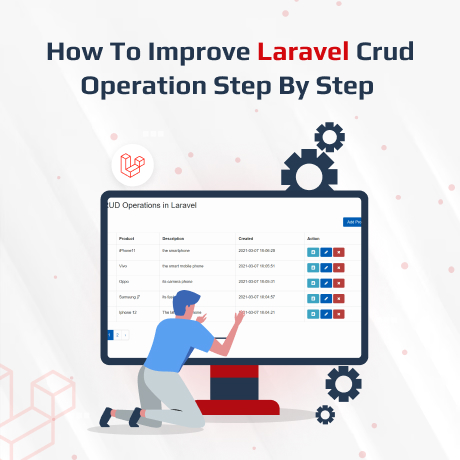
Improving CRUD (Create, Read, Update, Delete) Operations in Laravel can involve several steps, such as optimizing database queries as well as using best practices for code structure to leverage Laravel’s features. Consequently, this enhances both performance and maintainability. Therefore, here is a step-by-step guide to help you improve Laravel CRUD operations and ultimately streamline your development process.
1. Setup and Basic CRUD Operations
First of all ensure you have a Laravel application set up with basic CRUD operations. To begin with having the application ready is crucial. For example in this case, we’ll use a simple Post model in order to demonstrate the process more clearly. Additionally this model will help illustrate each step involved in improving CRUD operations.
Create the Model and Migration:
php artisan make:model Post -m
In the migration file (`database/migrations/xxxx_xx_xx_create_posts_table.php`):
Schema::create('posts', function (Blueprint $table) {
$table->id();
$table->string('title');
$table->text('body');
$table->timestamps();
});Run the migration:
php artisan migrate
Define the Model:
// app/Models/Post.php
namespace App\Models;
use Illuminate\Database\Eloquent\Factories\HasFactory;
use Illuminate\Database\Eloquent\Model;
class Post extends Model
{
use HasFactory;
protected $fillable = ['title', 'body'];
}2. Controllers and Routes
Create a controller:
php artisan make:controller PostController --resource
Define routes in `routes/web.php`:
Route::resource('posts', PostController::class);3. Basic CRUD Methods in Controller
Implement basic CRUD methods in the `PostController`:
// app/Http/Controllers/PostController.php
namespace App\Http\Controllers;
use App\Models\Post;
use Illuminate\Http\Request;
class PostController extends Controller
{
public function index()
{
$posts = Post::all();
return view('posts.index', compact('posts'));
}
public function create()
{
return view('posts.create');
}
public function store(Request $request)
{
$request->validate([
'title' => 'required',
'body' => 'required',
]);
Post::create($request->all());
return redirect()->route('posts.index')->with('success', 'Post created successfully.');
}
public function show(Post $post)
{
return view('posts.show', compact('post'));
}
public function edit(Post $post)
{
return view('posts.edit', compact('post'));
}
public function update(Request $request, Post $post)
{
$request->validate([
'title' => 'required',
'body' => 'required',
]);
$post->update($request->all());
return redirect()->route('posts.index')->with('success', 'Post updated successfully.');
}
public function destroy(Post $post)
{
$post->delete();
return redirect()->route('posts.index')->with('success', 'Post deleted successfully.');
}
}4. Views
Next create views for the CRUD operations. For simplicity let’s create basic views by placing them in the resources/views/posts directory. In this way you can easily manage and modify the views as needed. Additionally organizing them in this directory ensures that your code structure remains clear and maintainable.
index.blade.php:
@extends('layout')
@section('content')
<h1>Posts</h1>
<a href="{{ route('posts.create') }}">Create New Post</a>
@foreach ($posts as $post)
<h2>{{ $post->title }}</h2>
<a href="{{ route('posts.edit', $post->id) }}">Edit</a>
<form action="{{ route('posts.destroy', $post->id) }}" method="POST">
@csrf
@method('DELETE')
<button type="submit">Delete</button>
</form>
@endforeach
@endsectioncreate.blade.php and edit.blade.php:
@extends('layout')
@section('content')
<h1>{{ isset($post) ? 'Edit' : 'Create' }} Post</h1>
<form action="{{ isset($post) ? route('posts.update', $post->id) : route('posts.store') }}" method="POST">
@csrf
@if(isset($post))
@method('PUT')
@endif
<div>
<label>Title</label>
<input name="title" type="text" value="{{ old('title', $post->title ?? '') }}" />
</div>
<div>
<label>Body</label>
<textarea name="body">{{ old('body', $post->body ?? '') }}</textarea>
</div>
<button type="submit">{{ isset($post) ? 'Update' : 'Create' }}</button>
</form>
@endsectionshow.blade.php:
@extends('layout')
@section('content')
<h1>{{ $post->title }}</h1>
<p>{{ $post->body }}</p>
<a href="{{ route('posts.edit', $post->id) }}">Edit</a>
<form action="{{ route('posts.destroy', $post->id) }}" method="POST">
@csrf
@method('DELETE')
<button type="submit">Delete</button>
</form>
@endsection5. Improving CRUD Operations
Form Requests for Validation:
Firstly create a form request for validation. This approach ensures that subsequently all incoming data is thoroughly validated before it reaches your application logic. By doing so you can therefore maintain consistent data integrity and simplify your validation logic within controllers. Moreover using form requests not only centralizes validation rules but also enhances code readability and maintainability.
php artisan make:request StorePostRequest
Update the `PostController` to use the form request:
// app/Http/Requests/StorePostRequest.php
namespace App\Http\Requests;
use Illuminate\Foundation\Http\FormRequest;
class StorePostRequest extends FormRequest
{
public function rules()
{
return [
'title' => 'required',
'body' => 'required',
];
}
}
// app/Http/Controllers/PostController.php
use App\Http\Requests\StorePostRequest;
public function store(StorePostRequest $request)
{
Post::create($request->validated());
return redirect()->route('posts.index')->with('success', 'Post created successfully.');
}
public function update(StorePostRequest $request, Post $post)
{
$post->update($request->validated());
return redirect()->route('posts.index')->with('success', 'Post updated successfully.');
}Eager Loading:
To optimize database queries start by using eager loading to avoid the N+1 query problem. By implementing eager loading, you will reduce the number of queries and thus enhance performance. Furthermore this technique not only improves efficiency but also helps maintain a clean and manageable codebase.
public function index()
{
$posts = Post::with('comments')->get();
return view('posts.index', compact('posts'));
}Pagination:
To improve performance with large datasets begin by paginating the results. By doing so you will effectively manage data loads and thereby enhance response times. Additionally pagination not only optimizes query performance but also improves user experience by presenting data in manageable chunks.
public function index()
{
$posts = Post::paginate(10);
return view('posts.index', compact('posts'));
}Caching:
Cache query results to reduce database load:
use Illuminate\Support\Facades\Cache;
public function index()
{
$posts = Cache::remember('posts', 60, function () {
return Post::all();
});
return view('posts.index', compact('posts'));
}6. Testing
To begin with write tests to ensure your CRUD operations work as expected. By doing so you can identify potential issues early and thus improve the reliability of your application. Moreover comprehensive testing not only verifies functionality but also ensures that your code remains stable during future updates.
php artisan make:test PostTest
// tests/Feature/PostTest.php
namespace Tests\Feature;
use App\Models\Post;
use Illuminate\Foundation\Testing\RefreshDatabase;
use Tests\TestCase;
class PostTest extends TestCase
{
use RefreshDatabase;
public function test_can_create_post()
{
$response = $this->post('/posts', [
'title' => 'Test Title',
'body' => 'Test Body',
]);
$response->assertRedirect('/posts');
$this->assertDatabaseHas('posts', [
'title' => 'Test Title',
'body' => 'Test Body',
]);
}
public function test_can_update_post()
{
$post = Post::factory()->create();
$response = $this->put("/posts/{$post->id}", [
'title' => 'Updated Title',
'body' => 'Updated Body',
]);
$response->assertRedirect('/posts');
$this->assertDatabaseHas('posts', [
'id' => $post->id,
'title' => 'Updated Title',
'body' => 'Updated Body',
]);
}
public function test_can_delete_post()
{
$post = Post::factory()->create();
$response = $this->delete("/posts/{$post->id}");
$response->assertRedirect('/posts');
$this->assertDatabaseMissing('posts', [
'id' => $post->id,
]);
}
}Summary
Improving Laravel CRUD operations not only involves using best practices for validation but also includes optimizing eager loading, pagination, and caching. By implementing these techniques, you can significantly enhance performance and as a result create more efficient and scalable applications. Additionally, writing tests ensures the reliability of your CRUD operations. By following these steps, you can create efficient, maintainable, and scalable CRUD applications in Laravel.
FAQs: How To Laravel CRUD Best Practices Step By Step
CRUD stands for Create, Read, Update, and Delete. It’s a fundamental operation for managing data in a database, and Laravel provides tools to implement these operations easily through Eloquent ORM.
Use resource controllers, adhere to naming conventions, validate input data, use Eloquent relationships, and separate business logic from controllers by using services or repositories.
Start by setting up a new Laravel project, create a database and tables, generate models, controllers, and routes, then build the front-end to interact with your CRUD operations.
Resource controllers provide a systematic way to define routes and methods for CRUD operations, keeping your code organized and following RESTful conventions.
Eloquent ORM is Laravel’s built-in object-relational mapper that allows you to interact with your database using models. It’s used for CRUD operations because it simplifies database interactions with an expressive syntax.
Use Laravel’s built-in validation methods within your controllers or use Form Requests to keep validation rules organized and reusable.
Use try-catch blocks, validate input data, and handle errors gracefully by providing user-friendly error messages. Implement logging to track exceptions.
Use CSRF protection, sanitize user inputs, validate data, use parameter binding for SQL queries, and implement access control using Laravel policies and gates.
Yes, Laravel supports building APIs with CRUD operations using resource controllers and API routes, often enhanced by using tools like Laravel Sanctum or Passport for authentication.
Use eager loading to reduce the number of queries, index your database tables, cache data when possible, and optimize your database queries.
Laravel provides PHPUnit integration for testing. You can write unit tests for models, and feature tests for controllers and routes to ensure your CRUD operations work as expected.
Avoid putting business logic in controllers, not validating input data properly, ignoring relationships, and not handling exceptions gracefully.
Recommended Posts

Why Is The Laravel PHP Framework Secure & Best?
August 28, 2024



